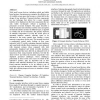Free Online Productivity Tools
i2Speak
i2Symbol
i2OCR
iTex2Img
iWeb2Print
iWeb2Shot
i2Type
iPdf2Split
iPdf2Merge
i2Bopomofo
i2Arabic
i2Style
i2Image
i2PDF
iLatex2Rtf
Sci2ools
AUIC
2015
IEEE
2015
IEEE
The Effectiveness of Transient User Interface Components
With small screen devices, including mobile and tablet based systems, becoming more common, the effective use of available screen space has become a critical skill in the design of user interfaces. Transient interface components are one technique that allows for a more complex interface to be displayed, in the form components that are only visible ‘on-demand”, without a significant or permanent on-screen footprint. This paper describes a study of transient user interfaces and the users perception of transient interface systems of different types, as applied in visually rich 3D environments. The primary objective of transient components is to free the screen space of unwanted interface controls, allowing space to be allocated to the main content, thus creating a more immersive experience for the user. This research involved a randomized control study looking at how users interacted with 3D worlds containing transient interfaces and in particular whether their experiences were enhan...
| Added | 16 Apr 2016 |
| Updated | 16 Apr 2016 |
| Type | Journal |
| Year | 2015 |
| Where | AUIC |
| Authors | Dale Patterson, Sean Costain |
Comments (0)

